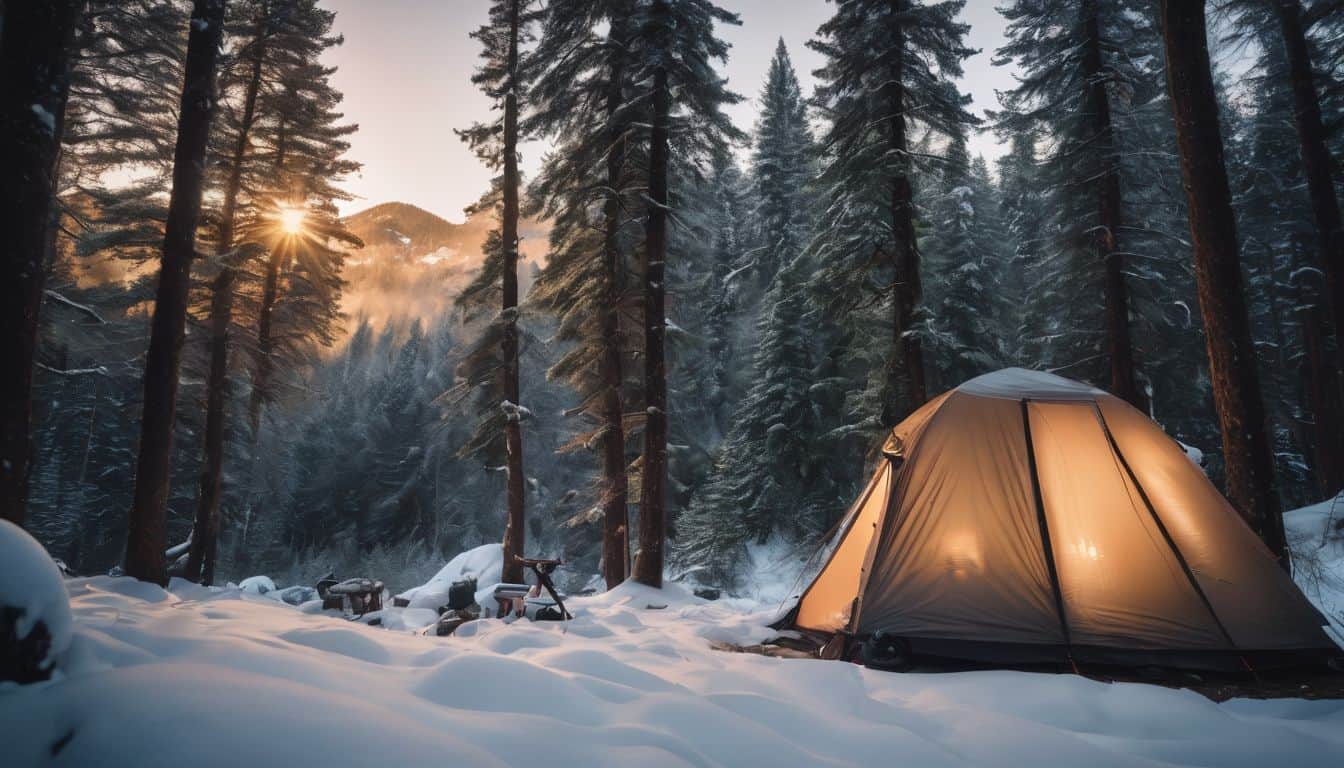Winter camping offers a unique and exhilarating experience for outdoor enthusiasts. The serene beauty of snow-covered landscapes and the challenge of braving the elements make it an unforgettable adventure. However, staying warm in snow requires careful preparation and the right techniques. This guide will help you embrace the winter wilderness safely and comfortably.
Introduction
Winter camping provides a chance to experience nature in its most pristine form. The benefits include crowd-free campsites, stunning winter scenery, and the satisfaction of conquering challenging conditions. Proper preparation is crucial for a safe and enjoyable experience.
The serene beauty of snow-covered landscapes offers a unique perspective on familiar terrain, and the crisp winter air can be invigorating. Wildlife viewing opportunities can be exceptional, as many animals are more visible against the white backdrop. However, the harsh conditions require meticulous planning and specialized gear to ensure safety and comfort.

Choosing the Right Campsite
Selecting an appropriate campsite is crucial for mountain camping and high-altitude adventures. Look for sheltered locations that offer protection from wind and avoid areas prone to avalanches. Ensure you’re near a water source, but be prepared to melt snow for water if necessary.
When choosing your site, consider the sun’s path to maximize warmth during the day. Look for natural windbreaks like rock formations or dense tree stands. Be aware of potential hazards such as dead trees that could fall under snow weight. In avalanche-prone areas, consult with local authorities or experienced guides to identify safe zones.
Setting Up Your Winter Camp
Prepare your tent site by packing down the snow and using snow anchors or deadman stakes for stability. Set up your tent with extra tautness to resist wind and create vestibules for gear storage. Packing down the snow creates a solid platform and helps insulate your tent from the cold ground. Use a snow shovel to create a level surface.
When setting up your tent, consider creating a snow wall on the windward side for additional protection. Ensure all guy lines are taut and use snow or ice anchors for added stability. A well-designed vestibule can serve as a transitional space to remove snowy gear before entering the main tent area.
Insulation Techniques
Proper insulation is key to staying warm. Use multiple sleeping pads, including closed-cell foam pads, for ground insulation. Choose the perfect sleeping bag for every season, ensuring it has an appropriate temperature rating for winter conditions.
Consider using sleeping bag liners for extra warmth. The ground can quickly sap heat from your body, so a combination of inflatable and foam pads provides the best insulation. For sleeping bags, look for models rated at least 10°F lower than the coldest temperature you expect to encounter. Sleeping bag liners can add an extra 5-15°F of warmth and help keep your bag clean.
Clothing and Layering Strategies
Employ a layering system with moisture-wicking base layers, insulating mid-layers, and waterproof outer shells. Always keep a set of dry clothes for sleeping. Start with a thin, moisture-wicking base layer to keep sweat away from your skin. Add insulating layers like fleece or wool for warmth. The outer layer should be waterproof and breathable to protect against snow and wind.
Avoid cotton as it retains moisture and loses insulating properties when wet. Pay special attention to extremities with warm socks, insulated boots, gloves, and a hat. Having a separate set of dry clothes for sleeping is crucial, as even small amounts of moisture can significantly reduce insulation effectiveness.
Managing Body Heat
Stay hydrated and well-nourished to maintain body heat. Exercise lightly before bed to generate warmth. Use hand warmers and hot water bottles for extra comfort. Proper hydration is crucial in cold weather, as dehydration can lead to reduced circulation and increased risk of hypothermia. Consume warm, high-calorie foods to fuel your body’s internal furnace.
Before settling in for the night, do some light exercises like jumping jacks or sit-ups to raise your core temperature. This extra warmth will help you stay comfortable as you fall asleep. Strategic placement of hand warmers in pockets or boots can provide localized warmth, while hot water bottles can be placed in your sleeping bag for all-night comfort.
Tent Comfort and Safety
Ensure proper ventilation to prevent condensation. Use safe heating methods and organize your gear for easy access. Condensation can be a major issue in winter camping, as moisture can freeze and reduce insulation effectiveness. Keep vents open and avoid breathing into your sleeping bag. If using a heating source, ensure it’s designed for tent use and follow all safety guidelines.
Carbon monoxide poisoning is a serious risk with improper heating methods. Organize your gear methodically, keeping essential items within reach. This organization prevents you from exposing yourself to cold air while searching for items and helps maintain the warm microclimate inside your sleeping bag.
Cooking and Eating in Winter Conditions
Set up a snow kitchen, plan high-calorie meals, and use insulated containers to keep water from freezing. A well-designed snow kitchen can provide a comfortable cooking area and protect your stove from wind. Dig a pit in the snow and use snow blocks to create walls. Plan meals that are easy to prepare and high in calories and fat to fuel your body.
Soups, stews, and hot drinks are excellent choices. Use insulated containers or keep water bottles inside your sleeping bag to prevent freezing. Remember that your body burns more calories in cold weather, so pack extra food.
Additional Warmth Strategies
Use tarps for wind protection and create snow walls as windbreaks. Utilize natural features for additional shelter when possible. A well-placed tarp can significantly reduce wind chill and create a more comfortable camp area. Snow walls can be built around your tent for additional protection; pack the snow tightly for better insulation.
Look for natural features like large boulders or dense tree stands that can provide shelter. In emergency situations, snow caves or quinzees can offer excellent insulation and protection from the elements.
Safety Considerations
Be aware of the signs of hypothermia and frostbite. Always be prepared for emergencies and maintain your gear properly in cold conditions. Know the early symptoms of hypothermia, such as shivering, confusion, and loss of coordination. For frostbite, watch for numbness, skin discoloration, and a waxy appearance on exposed skin.
Carry an emergency kit with first aid supplies, extra food, and emergency shelter. Regularly check and maintain your gear, as equipment failure can be dangerous in winter conditions. Keep batteries warm, as cold temperatures can significantly reduce their life. Always inform someone of your trip plans and expected return time.
Conclusion
Winter camping can be a rewarding experience with the right preparation and knowledge. By following these guidelines, you can stay warm and safe while enjoying the beauty of winter landscapes.
For those who prefer a more luxurious outdoor experience, consider glamping year-round, which offers comfort in all seasons, including winter.
Remember, the key to a successful winter camping trip is thorough preparation, the right gear, and a respect for the winter environment. Stay safe, stay warm, and enjoy the unique beauty of winter camping!

Leave a Reply